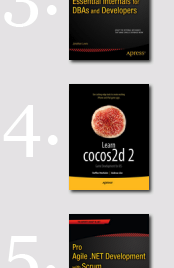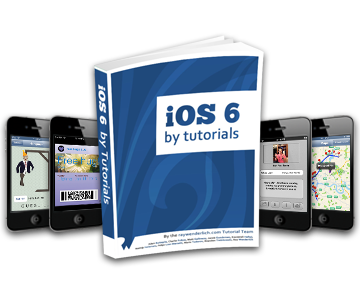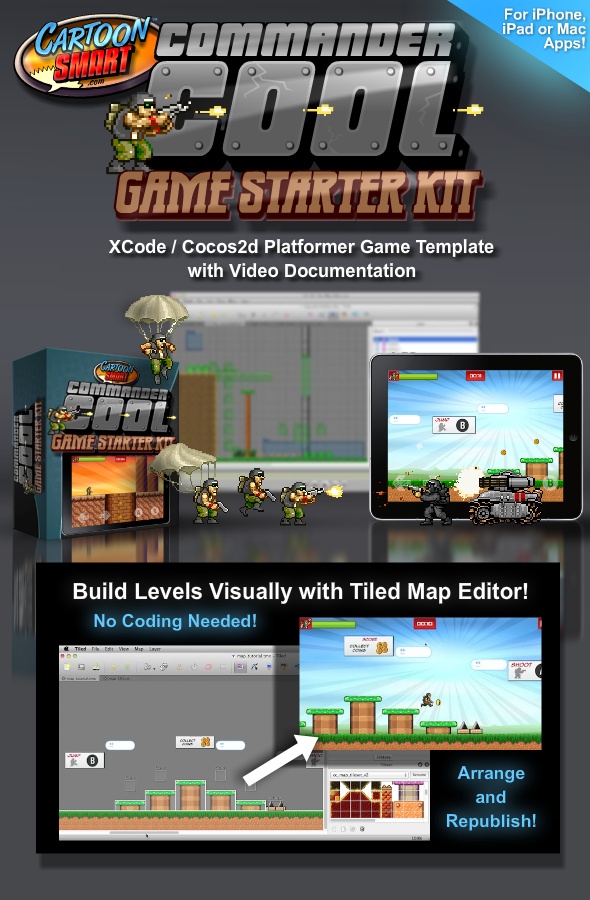Learn cocos2d 2 is hot off the press and it once again entered Apress’ weekly bestseller chart (see banner on far right).
Now with iOS 6 released it’s about time I updated my Affiliate Products page.
Because there have been some awesome new products released. In order of most recently released:
iOS 6 by Tutorials
Ray Wenderlich and his team wasted no time in releasing this massive 1,500 pages tutorial double-whopper that’s actually a 5-star iOS 6 gourmet menu!
Commander Cool Game Starter Kit
Create your own platformer game for iOS and Mac with this game kit made with Cocos2D. As always with CartoonSmart products, you get an hour-long video documentation. Jump, run and be cool!
Paralaxer: Cross-Platform Platformer Kit
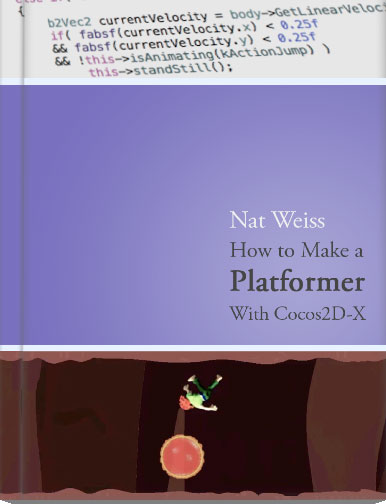
|
Paralaxer is possibly the first commercial game kit available that uses Cocos2D-X. Ported to iOS, Android, Windows and Mac it also comes with a free ebook “How to Make a Platformer Game With Cocos2D-X” by Nat Weiss - who previously created the iPhone Action RPG engine.
If you’re working with Cocos2D-X you should spend $49 (limited time) on this excellent starter kit!
It’s a worthy investment, and so far the only really good example code plus documentation resource for Cocos2D-X you can find.
I think it’s about time to issue a KoboldScript status update. KoboldScript is Lua scripting for cocos2d, in case you didn’t know. In the near future it’ll be released as part of the KoboldScript Game Kit project. I showcased KoboldScript before here and here.
Static bindings, manual labor
One big advantage of KoboldScript over other script language solutions available for cocos2d is that the KoboldScript binding is static, ie it is done at compile time. There’s very little runtime overhead to it, thanks to SWIG. So in terms of performance it’s miles ahead of Wax, LuaCocoa or other dynamic scripting language bindings like JSCocoa. And it is compatible with both Mac OS X and iOS.
The big problem with static bindings is that you have to somehow define each class, each method, each property and write lots of glue code. In the past, I did this manually. It involved writing a C wrapper method for SWIG and usually an Objective-C dispatch function went along with it. On the Lua side the function needed to be registered as well. It’s an error prone, repetitive, boring task. Perfect for code generation! Continue reading »
 Here’s a crazy thought: with commercial game kits (game source code products) being popular and financially rewarding – why not crowd-fund an iOS game by selling it’s source code, resources and development insights while you’re creating it?
Here’s a crazy thought: with commercial game kits (game source code products) being popular and financially rewarding – why not crowd-fund an iOS game by selling it’s source code, resources and development insights while you’re creating it?
Marcus and I will give this idea a spin. Marcus is a game designer I worked with at Electronic Arts Phenomic for 6 years. I’m sure you know me. Together we’re going to create a tilemap-based physics game using cocos2d and KoboldScript (Lua scripting for cocos2d). And we are going to sell everything we’ll create practically from day one.
If that sounds even slightly intruiging to you, we’d love to get your feedback!
Visit the launch page and take our survey which has already helped us tremendously to focus on what’s important for you. For example I’ve converted the entire KoboldScript library to use ARC seeing how important ARC is to you.
But do keep on reading for more details … Continue reading »
The latest episode of the Cocos2D Podcast has a special guest: Nate Weiss, developer of the commercial iPhone (RPG) Game Kit.
Nate is one of the most enthusiastic game developers I know, his true love being RPG games. When not making games he loves to help others learn game development and makes a living off of that.
And he does all that from the confines of his floating apartment: he lives on a boat!
To top all that the Cocos2D Podcast now has an intro music provided by Marco Neumann aka @marcotronic. Thanks Marco, rock on!
Cocos2D Podcast: Nathanael Weiss (iPhone Game Kit Developer)
PS: I actually forgot to publish this post after I was done writing it. It was sitting here as draft for a week. I’m sorry for the delay!
The latest episode of the Cocos2D Podcast is out!
This time Azam and I talk about the options you have to earn additional revenue from or with your apps, using iAd ads, In-App Purchases, selling your source code and other ideas.
Cocos2D Podcast: Earning Additional Revenue
You might also want to read my blog post How to make over $18,000 in six months selling source code about the financial success of my Line-Drawing Starterkit. By the way, I’ll be releasing a new game kit in autumn. More details in the coming weeks.
An ongoing discussion about how to correctly send/receive data with Game Kit on Cocos2D Central prompted me to write a demo project to complement the Learn Cocos2D book’s Game Center chapter. The resulting working code is in this post, and also reprinted below.
The Game Kit Data Send/Receive Demo Project (download here) is based on the Learn Cocos2D book code made for the Game Center Chapter. It’s called Tilemap16 just to stay in line with the naming scheme.
You control the little Ninja as usual, but this time anytime you move it, it will also move on all other connected devices because the tile coordinate is sent via Game Kit to all connected players but only when it actually changes. The demo even allows you to move the Ninja on any device, and all others will follow, so it truly works in every direction. In addition, a score variable (int) is transmitted every frame just to show how to send different types of data at different times.
I wish I could have made a movie to show how cool this is but alas, my iPod was busy running the demo, so all I can show as proof is my iPod and iPad running the game with both Ninjas at the same position (mushy image made with my already-ancient iPhone 3G under perfect programming but terrible lighting conditions):
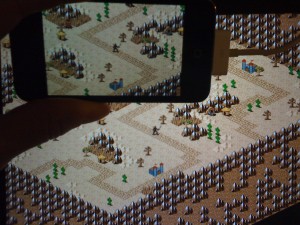
Source Code Example
In summary this is the code that’s used to send/receive data with the help of the GameKitHelper class I wrote for the book (also included in the download and free to use for anyone and any purpose):
[cc lang=”ObjC”]// add this to the header
typedef enum
{
kPacketTypePoint,
} EPacketTypes;
typedef struct
{
EPacketTypes type;
} SPacketInfo;
typedef struct
{
EPacketTypes type;
CGPoint point;
} SPointPacket;
[/cc]
Sending a packet:
[cc lang=”ObjC”]
-(BOOL)ccTouchBegan:(UITouch *)touch withEvent:(UIEvent *)event
{
CGPoint location = [touch locationInView: [touch view]];
SPointPacket packet;
packet.type = kPacketTypePoint;
packet.point = location;
gkHelper = [GameKitHelper sharedGameKitHelper];
[gkHelper sendDataToAllPlayers:&packet length:sizeof(packet)];
}
[/cc]
Receiving the packet:
[cc lang=”ObjC”]
-(void) onReceivedData:(NSData*)data fromPlayer:(NSString*)playerID
{
// first, assume it’s the general SPacketInfo, that way we can access type
SPacketInfo* packet = (SPacketInfo*)[data bytes];
switch (packet->type)
{
case kPacketTypePoint:
{
SPointPacket* pointPacket = (SPointPacket*)packet;
CCLOG(@”received point: %.1f, %.1f”, pointPacket->point.x, pointPacket->point.y);
break;
}
default:
CCLOG(@”received unknown packet type %i”, packet->type);
break;
}
}
[/cc]
Requirements & Setup
You need:
- 2 devices which are Game Center capable, eg they must have the Game Center App installed. If it isn’t, that device is not ready for Game Center. 1st & 2nd Generation devices up to iPhone 3G do not support Game Center. In addition Simulator will not work due to Matchmaking/Invites not being supported on the Simulator.
- 2 Game Center accounts (you can create dummy accounts via the Game Center App)
What you have to do:
- Create a new App on iTunes Connect, enable Game Center for that App, and replace the Bundle ID of your App with the one in the project’s info.plist. Please refer to the Game Center section in the iTunes Connect documentation.
- Make sure Push Notifications are enabled on all devices via Settings App.
- Run the Game Center App on both devices, login and make sure each device is logged in with a unique account. Then invite the other device’s account as friend and accept the friend request, this makes it easier to join each other’s matches.
- Build the Tilemap16 App and deploy it to both devices. Whenever you make a change to the code, you must deploy the App to both devices again, to make sure they run the same code.
- Run the App on one device, wait for the matchmaking screen to appear. Invite your other device’s friend account to join the match.
- Wait on the other device for the match invite to pop up. Tap Accept. The Tilemap16 game will launch.
- Tap Play Now on the first device once the other player has successfully connected and is ready.
- Move the Ninja on either device and watch it move on the other.
Enjoy!
Nate Weiss, author of the commercial iPhone Game Kit, would like you to help build the first community driven RPG game for the iPhone. Read his announcement.
He wrote a game design document for you to wet your appetite and learn what needs to be done. It’s an ambitious project that I believe would be awesome to take part in, especially if you don’t have the time and energy to build a complete game project by yourself, but you still like to take part in fruitful game development activities. What the game needs most is to design levels using the popular Tiled Map Editor, and new artworks for tiles, characters and cutscenes.
You do need to have a copy of the iPhone Game Kit to participate, but currently it’s on sale with 30% off and costs only $69. For that you get the complete source code and assets for the Quexlor action RPG and a 150 page game development eBook. I think his product and ebook are excellent and well worth the money, and I’m currently running two ads for Nate on a voluntary basis. You can learn more about the pros and cons of the iPhone Game Kit from these independent reviews:
Add your link to the Cocos2D Linkvent Calendar
Do you have something to share with the Cocos2D community? I haven’t received enough submissions to fill all the days until Xmas, although I do have enough links to post one each day, I’d rather post a link to your website or blog post.
Chapter 15 - The Final Chapter
This is it. The last one. I don’t know what’s going to be in it. It’s supposed to give the reader a “where to go next” kind of outlook. I hope that one of the places will be here, but obviously there’s tons of places to go and tons of things for cocos2d developers to learn.
If you have a particular idea what should be included in the greater cocos2d developer outlook kind of sense, please let me know!
Summary of working on Chapter 14 - Game Center
Amazing! Simply amazing. I think I fell in love with Game Center in the process, I haven’t worked with a networking API that’s so smooth, straightforward and easy to comprehend. No thanks to Apple’s already excellent step-by-step documentation. Still, there were a couple pitfalls and things that one could forget, and I did, that I’ve obviously included in the chapter.
On the other side, with almost a week late for this chapter, I realized how time consuming network programming is. There’s a lot of testing going on, and especially if you’re testing on two devices the process is incredibly inefficient compared to a simple single-player game. You always have to deploy to two devices for every test, and every time the delay between request and response adds to the time spent on testing. Add to that common network errors such as a drop in connection or something blocking the line with a download, and you’re up for a fun ride.
But that alone didn’t account for the one week delay. In the past two weeks I’ve been helping to renovate someone’s apartment, I got a cold, I held a presentation at the Macoun Mac OS X conference (about cocos2d obviously) while still recovering from the cold. Then our pet cat Yoshi had to see the vet and almost died during anesthesia because of a pulmonary edema. On the brighter side I’ve also attended a wedding and wrote a GameKitHelper class for this chapter which contains more stuff than I could describe in the book, including storing achievements which failed transmission, as is recommended but not implemented by Apple’s Game Center Programming Guide.
That’s also why I haven’t been answering emails timely recently. Please be patient, I’ll get to yours soon!
What’s left?
Now that I’m almost finished writing the book, what’s left? Obviously I have to review technical and other edits done by Apress. Current chapter 13 is in technical review while chapter 6 is in editorial review, after which it’s ready for production. So I’ll still be busy reviewing and making changes and additions to chapters during October and probably even November.
Then there’s the issue of the example projects having used three different versions of cocos2d, starting with 0.99.3. That was actually an oversight on my part because at the time I had 0.99.4 available. Luckily those changes are really insignificant for the first few projects. The DoodleDrop game already uses 0.99.4 and so does most of the book’s code. But for the Game Center chapter, I had to migrate the Tilemap project from 0.99.5 beta 1 to beta 3 and that was a huge step. It was easier to simply create a new project from the latest cocos2d template, then re-adding all game source code and resources to the new project. Still, that’s doable.
The bigger issue I have here is the fact that I can’t change anything in the book anymore, so the code should reflect what’s in the book. If the book mentions CCLabel then the code should use CCLabel and not CCLabelTTF. What I think is probably going to be a good compromise is to update the important (final) versions of each chapter’s example projects to cocos2d v1.0 once that is released. Obviously the code supplied with the book will remain as it is described in the book, so the upgraded code would be for reference only and a separate download. Whether I wait for v1.0 depends on how progress towards v1.0 is coming along around the book’s release date some time in December 2010.
In hindsight, I really wished I had used my Xcode template project and used that throughout the book. Back then I decided against it because it was important for me to write the code like almost all cocos2d developers would do. Now I regret the decision because I could have changed the way cocos2d developers start new cocos2d projects for the better. The whole updating process for cocos2d is a major PITA and then some, so I think I need to bring this issue to the table more frequently, more actively. At least until the cocos2d template installation procedure is changed to not copy all of the source code into each new project and then leaving it up to the developer to deal with upgrades.



